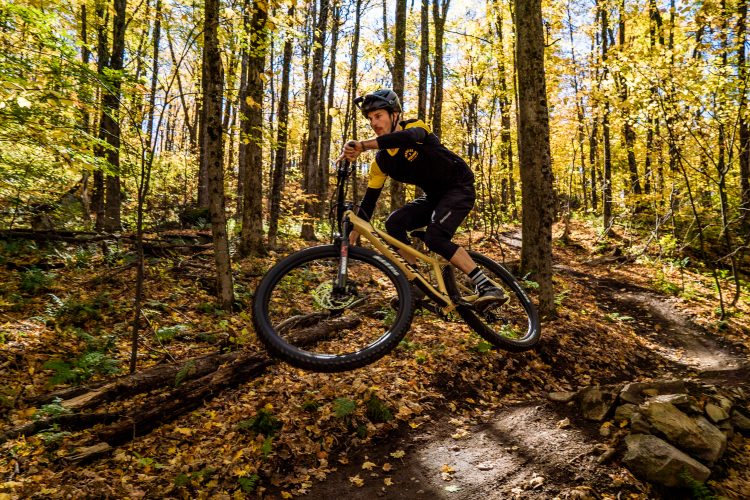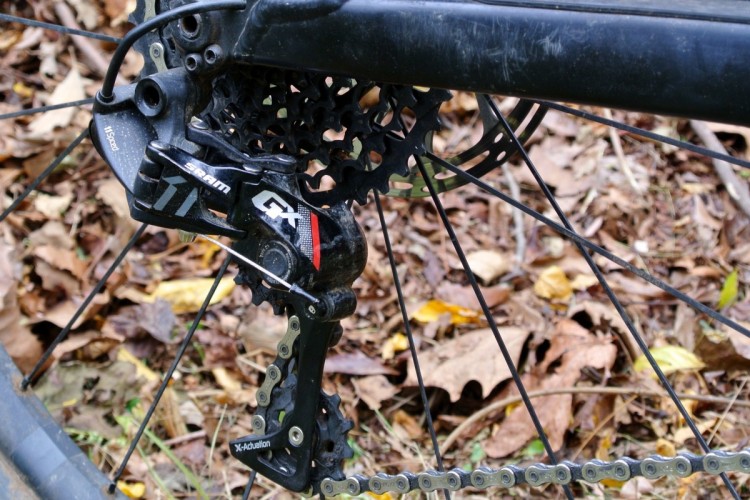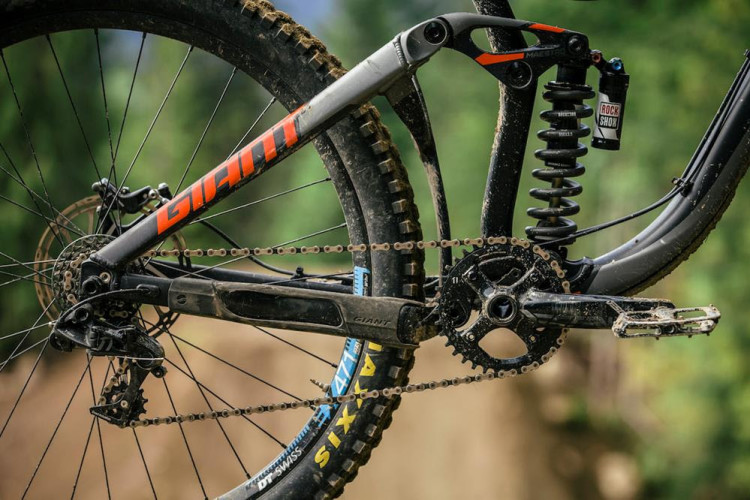Evaluating build kit options can be daunting when buying a new mountain bike. Does it make sense to spend another $500 for a more tuneable fork? Or is it more wise to go with an aluminum frame and better components? Is a carbon wheel set really worth the $1,000 up-charge? Most of us just want to know what’s worth spending money on, and what isn’t. In the end, it’s subjective to every buyer, but companies take great consideration into every part that goes onto a bike.
To get a better feel for mountain bike build kits, we analyzed several brands and spoke with brand representatives and CEOs to see what goes into models at different levels.
How are builds priced?
There are price points that brands strive to hit because consumer segments are fairly consistent year after year. Beginners buy affordable bikes. Enthusiasts and athletes will spend more. There are usually predictors that make it safe to offer similar price points on build kits every year.
However, factors like the strength of the economy, technology, and currency values change, and brands need to adjust. By communicating with dealers on the front lines and watching how consumers buy, a brand can adjust their pricing strategy.
Although Pivot Cycles offers multiple build kits for certain models, their strategy for categorizing builds is a little different, says Chris Cocalis.

“Price is always an important factor but so is the level of performance and long-term durability. We won’t compromise the quality of a part just to hit a specific price point.”
Cocalis notes that consumers don’t regard Pivot as a company that offers an entry-level build, either. Most of their bikes are carbon fiber, with usually Shimano XT components and above.
The aluminum Switchblade or Mach 6 with Shimano XT components are two of Pivot’s most affordable mountain bikes and both ring in near $4,000.

Rocky Mountain product manager Ken Perras also says that they aren’t trying to categorize bikes by price either.
“We prefer to create tiers based on technology, such as having an aluminum or carbon frame and equipment that offers more performance, albeit at higher costs. We also need to take advantage of our suppliers’ offerings, so it makes sense to have tiered models that follow their take on levels of performance.”
What makes a good build?

When a company splits a model into different builds, they strive to offer something that they’re proud of, and that a customer is proud to buy. Regardless of the cost or components, any premium bike should last years, and if maintained correctly it should outlast the buyer. Still, there’s debate about what a good build is and is not.
For Devinci, it’s an easy choice. On all of their build kits, they strive to keep a few things the same, no matter what.

“The main points of focus are brakes, suspension, and tires. It’s all about providing the best of three components on a different price target,” says Devinci product manager Simon Pelchat.
Pelchat says that suspension is important to get the most out of the frame, as is the braking system since it allows riders to control their speed. Even on these three components, though, Devinci still has a favorite.
“A good set of tires allows you to keep the control of your bike in the worst situations. No matter the level of your build kit, if you have good tires, it’s already a very good start for the customer.”
Maxxis triple compound, wide-trail tires are the standard on Devinci trail bikes like the Troy and Spartan, whether it’s a $3,200 or $8,800 build.
Perras from Rocky Mountain has a different perspective on consistency.
“Everything is subject to review based on shifting goals with each model. An example of shifting consistency (both a pun and an oxymoron I know),” he writes, “is that we’ve always had XT drivetrain equipped models in our lineup. However, in recent years, SRAM has introduced drivetrain technology that has been able to unseat Shimano’s grip on drivetrain spec.”
What sells the most?

That SRAM Eagle drivetrain at an affordable GX price point has worked for both brands and consumers.
“Typically we sell more bikes that feature a carbon front triangle and build kits that feature entry level price-points to the latest technology. An example of this would be SRAM’s GX Eagle drivetrain, as up until recently it was their most affordable 12-speed drivetrain,” says Perras.
In Rocky’s lineup, it would be a bike like the carbon Altitude C50, with a SRAM Eagle drivetrain for $4,400.
Devinci’s Pelchat had the same to say. An aluminum GX-specced Troy sells for $3,750 and the carbon model sells for $5,000.
“It depends for each bike model, but we usually do very well with GX level build kits. It’s a mid-range build that offers excellent value for the money. You have a great range of adjustability, good precision, a fairly light weight and great durability. My mentality on these builds is really to put the money ‘where it matters’ for core riders.”
Consistency across a model
Considering that components change so drastically across different builds, it seems like it’d be hard to keep consistency across one model.
Devinci notes that tires, good suspension, and good brakes are something that they strive to keep the same across builds. Pivot’s alternative take on categorizing builds yields a different response.
“Performance,” says Cocalis. Getting the most out of a frame is a high priority for Pivot, and for them that means not speccing entry-level products on bikes.

“Every build kit we offer, regardless of price, must let our bicycles perform at a level that lives up to the potential in the frame. No single part can hold our bikes or the riding experience back. Our build kits start at what most would sell as a mid-level build because of this.”
Decisions
There are a lot of factors that determine which components are specced on a build. Brands have relationships with suppliers, need to consider serviceability of the components, and of course take into account the quality of the components.
“We all have our biases, but those are becoming less relevant as the performance window of components narrows,” says Rocky Mountain’s Perras, (think Shimano versus SRAM). “In the end, the relationship with our suppliers and the service they offer becomes a major factor in spec.”
Cocalis says there’s quite a bit of testing that goes into a decision of what to spec as well.
“We test a wide range of components to get a feel for their performance and durability before even considering them for our kits,” he says.
When Pivot still can’t find the right part for a bike, they develop their own with partners. He notes that this happened with the Reynolds carbon wheels and the Maxxis 27.5+ tires on Mach 5.5s and the Switchblade 27.5+.
“Once [a component] makes the cut, we put together builds that meet the great, better, best categories and try to hit certain price ranges.”
Bottom versus top-shelf

No matter how brands dice it up, paying more for a bike is going to grant a buyer better performance. Paying less means less adjustability, and performance, but not necessarily less bike.
“Nowadays, I feel that mountain bikes are better than ever and the differences between [them] are more subtle, yet substantial in a completely different way that experienced riders can feel, and beginner riders can be (unknowingly) satisfied that they aren’t missing out on anything crucial,” says Perras. “$2,500 bikes are now coming with technology that was present on $6,500 USD bikes five years ago.”
Things like dropper posts, decent fork dampers, and tubeless tires were mostly absent on entry-level builds even five years ago. Most come standard with these components now. It’s clear that there’s still one area that an entry-level build sacrifices, though.
“The most affected area of a lower cost bike is weight due to the use of simpler materials and less cost-intensive designs,” says Perras.
But, there seems to be a point of diminishing returns as prices rise as well.
“Generally speaking, you get what you pay for regarding build kits — to a point,” says Cocalis. “There is a bell curve where overall bang for the buck starts to decrease but there are still gains in every metric of performance,” he says. “Most riders know that a SRAM XO1 group performs nearly identically to their XX1-level group, yet there is a weight savings, and of course it’s hard to ignore the overall look and finish of the highest end components.”
A closer look at what you get
Under $2,500

Although it’s possible to get a well-specced hardtail for under $2,500, a full-suspension mountain bike below this price is going to include base-level components that err on the side of function, rather than performance.
That means things won’t be quite as smooth or as light as on a higher end build kit. Still, spending $2,500 on a bike doesn’t mean buyers are getting junk.
At this price point, frames are most likely aluminum. Several brands have backtracked in the past year or two to up their aluminum frame options after the lower-cost frame material nearly went away. Going this route just means that the bike will probably weigh a bit more.
Suspension choices are also a bit heavier and more sluggish, but still work well. The aluminum and steel RockShox Recon is a popular fork option for bikes in this price range. Steel makes it heavier, and potentially more flexy, but it still has an air spring and a low speed compression dial to lock out the suspension.
At this price point, brands are more likely to use their own branded components for the cockpit and seat post, and possibly the wheel set. Shimano SLX or Deore drivetrains and brakes are usually the go-to, since SRAM Guides and Levels are a bit more costly.
$2,500-$4,500
Things start to get a little bit more interesting at this price spec. Forks get better dampers, brakes get a little more serious, and dropper posts essentially become standard.

Here you’ll see forks like the RockShox Revelation with 35mm stanchions and DebonAir air spring, or the Fox Performance 34 with a Fit 4 or Grip damper. That means more adjustability and tuning options for a better ride feel.
High-range drivetrains also become a near standard in this price range, thanks to the SRAM NX and GX Eagle options on the market today. The theme here isn’t budget-minded components, but lower-priced options on quality components.
$4,500-$6,500

Above the $5,000 mark, brands equip their bikes with premium-level forks, drivetrains like the SRAM GX Eagle, and brakes like Shimano XT. Bikes also feel more “race-ready” in this price bracket. Shifting is faster, suspension is smoother, and brakes stop quicker and stay cooler. This level of performance won’t hold anyone back if they’re on the clock. The durability and longevity of components grows too.
$6,500 and up

For most of us, this reflects premium and top-level pricing. Forks like the Rock Shox Lyrik RC2 or Fox 36 Factory with high and low-speed compression and rebound tuning are generally found here. Carbon wheels become likely and lightweight for stiffer, faster-rolling performance. And, 12-speed drivetrains like the SRAM XX1 Eagle or the new Shimano 12-speed XTR are the norm. The bikes are race-ready and performance and weight is the first consideration.
Your turn: How do you think mountain bike brands can improve their build kits and/or pricing?






















3 Comments
Jan 30, 2019
My personal preference follows what Simon Pelchat from Devinci stated, great quality brakes, tires and suspension. Powerful brakes, tuneable suspension and heavy duty sidewall tires. I also prefer a higher end shifter and lower end derailleur vs better derailleur and lower end shifter. I really like the smooth feeling at my fingertip. Shifters take less of a thrashing so I know the added cost goes further in the long run than spending extra on a part that gets beat up often.
Jan 30, 2019
Jan 30, 2019